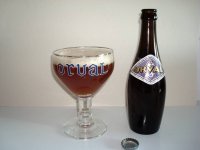theBaron
Major
- Joined
- Mar 27, 2008
- Messages
- 10,522
The Germans started marking their glasses because of the issue of getting every Pfennig's worth in a draught. But it's not the pour that must reach the line, but the final level, once the head has settled a little. So you'll see the barman tap a liter mug, and the liquid might not reach the line immediately, but it settles in a minute or two.
Another note on volume-German beers are usually bottled in half-liters, except for pilseners, which are bottled in .33L or .5L. And that's what we used to get here in the States. But about 10 years ago or so, they started shipping nearly everything in 12oz bottles for the American market (or .33L, which is close). But the price per case remained the same, so you got about a third less beer, for the same price. All because we've been trained to drink beer in smaller amounts.
Wheat beers are still sold in the traditional half liters, though they're also available in the little girl bottles, too.
You'll love this, too-in Pennsylvania, the state controls alcohol sales through its Liquor Control Board (LCB). They license distributors who sell beer and soda, and operate state stores, to sell wine and spirits. They've been in bed with the liquor store employee's unions and the associations of beer distributorships and bar owners to prevent or restrict sales of beer in outlets like supermarkets, and in any increments other than a case, or in six packs, from a bar.
The LCB has made changes, though, because of competition with our neighbors to the east (New Jersey) and the south (Delaware), and others, that allow bottle sales, and sales in grocery stores. The state sotres have improved from dingy little holes-in-the-wall that looked like stores in the Soviet Union must have looked like, into nicely done stores with a much better selection than before. And one supermarket chain (Wegman's) has wrangled an arrangement to sell beer in its takeout cafes. The deal was that the cafe is treated as a separate entity from the larger grocery store, and not as a beer aisle.
Still, here in PA, you can brew up to 300 gallons for your own use, free of tax and licensing. We can thank our colonial forebears for that.
Prost!
Brad
Another note on volume-German beers are usually bottled in half-liters, except for pilseners, which are bottled in .33L or .5L. And that's what we used to get here in the States. But about 10 years ago or so, they started shipping nearly everything in 12oz bottles for the American market (or .33L, which is close). But the price per case remained the same, so you got about a third less beer, for the same price. All because we've been trained to drink beer in smaller amounts.
Wheat beers are still sold in the traditional half liters, though they're also available in the little girl bottles, too.
You'll love this, too-in Pennsylvania, the state controls alcohol sales through its Liquor Control Board (LCB). They license distributors who sell beer and soda, and operate state stores, to sell wine and spirits. They've been in bed with the liquor store employee's unions and the associations of beer distributorships and bar owners to prevent or restrict sales of beer in outlets like supermarkets, and in any increments other than a case, or in six packs, from a bar.
The LCB has made changes, though, because of competition with our neighbors to the east (New Jersey) and the south (Delaware), and others, that allow bottle sales, and sales in grocery stores. The state sotres have improved from dingy little holes-in-the-wall that looked like stores in the Soviet Union must have looked like, into nicely done stores with a much better selection than before. And one supermarket chain (Wegman's) has wrangled an arrangement to sell beer in its takeout cafes. The deal was that the cafe is treated as a separate entity from the larger grocery store, and not as a beer aisle.
Still, here in PA, you can brew up to 300 gallons for your own use, free of tax and licensing. We can thank our colonial forebears for that.
Prost!
Brad






